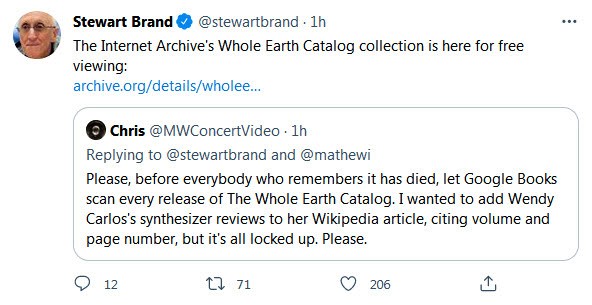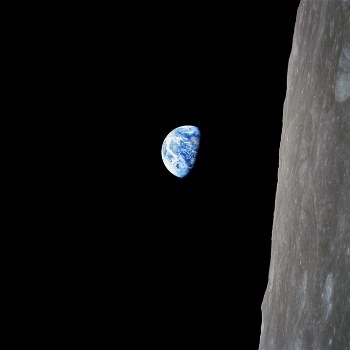File:Whole earth catalog 1969.jpg: Difference between revisions
Siterunner (talk | contribs) No edit summary |
Siterunner (talk | contribs) No edit summary |
||
| Line 19: | Line 19: | ||
<big>''' | <big>'''GreenPolicy360 explores the big picture beginning of the [[Environmental movement]]'''</big> | ||
Revision as of 18:04, 30 April 2021
On the cover, Earthrise', the first 'whole earth' photo
Nature photographer Galen Rowell declared it "the most influential environmental photograph ever taken."
The 'Earthrise' photograph was not on the mission schedule and was taken in a moment of pure serendipity.
- ·························
GreenPolicy360 explores the big picture beginning of the Environmental movement
Stewart Brand: The Man Who Changed the World, Twice
By David Brooks / New York Times
(Reprint courtesy of D. Brooks)
May 7, 2018
This column is about a man who changed the world, at least twice. I want to focus less on the impact of his work, which is all around us, and more on how he did it, because he’s a model of how you do social change.
Stewart Brand was born in Rockford, Ill., in 1938, the son of an advertising executive. By the early 1960s, he felt alienated from boring, bourgeois suburbia and concluded that Native Americans had a lot to teach the rest of us about how to lead a more authentic way of life.
In 1965, he created a multimedia presentation called “America Needs Indians,” which he performed at the LSD-laced, proto-hippie gatherings he helped organize in California.
Brand then had two epiphanies. First, there were no public photos of the entire earth. Second, if people like him were going to return to the land and lead natural lives, they would need tools.
He lobbied NASA to release a photograph of the whole earth, which became an iconic image for the environmental movement. Then he slapped the picture on the cover of what he called the “Whole Earth Catalog.”
The catalog was an encyclopedia of useful items for people heading to a commune — home weaving kits, potter’s wheels, outdoor gear. But it was also a bible for what would come to be known as the counterculture, full of reading lists and rich with the ideas of Buckminster Fuller and others.
“Whole Earth Catalog” sold 2.5 million copies, won the National Book Award and defined an era.
When a culture changes, it’s often because a small group of people on society’s margins find a better way to live, parts of which the mainstream adopts. Brand found a magic circle in the Bay Area counterculture. He celebrated it, publicized it, gave it a coherence it otherwise lacked and encouraged millions to join.
The catalog featured an iconic central character, the Cowboy Nomad, who served as symbol and role model. Brand took influences from different parts of America — the New York art world, farmers, academic visionaries like Marshal McLuhan — and synthesized them into one ethos. He crowdsourced later editions, asking readers to recommend other cool products to feature.
The communes fizzled. But on the other side of the Bay Area, Brand sensed another cultural wave building. Back in the 1960s, computers seemed like the ultimate establishment device — IBM and the government used them to reduce people to punch cards.
~
But Brand and others imagined them launching a consciousness revolution — personal tools to build neural communities that would blow the minds of mainstream America. As Fred Turner says in “From Counterculture to Cyberculture,” “What the communes failed to accomplish, the computers would complete.”
Brand played cultural craftsman once again, this time first as a celebratory journalist. In 1972 he wrote a piece for Rolling Stone announcing the emergence of a new outlaw hacker culture. The hackers were another magic circle on the cutting edge of the future, a circle Brand would publicize and inspire others to join.
As my Times colleague John Markoff, who is writing a biography of Brand, notes, Brand is a talented community architect. In the 1970s, he was meshing Menlo Park computer geeks with cool hippie types. The tech people were entranced by “Whole Earth,” including Steve Jobs and Frederick Moore, co-creator of the celebrated Homebrew Computer Club.
Brand meshed the engineers with the Merry Pranksters and helped give tech a moral ethos, a group identity, a sense of itself as a transformational force for good.
In 1985, Brand and Larry Brilliant helped create the Well, an early online platform (like Usenet) where techies could meet and share. He helped Kevin Kelly organize hacker conferences, which attracted media attention. As Silicon Valley became more corporate in the 1980s and 1990s, he also helped form the Learning Conferences, Worldview Meetings, the Global Business Net and other convenings that gathered the multidisciplinary theorists and journalists who would define the wired culture: Kelly, Esther Dyson, Tim Berners-Lee and Nicholas Negroponte.
Brand’s gift, Frank Foer writes in “World Without Mind,” is “to channel the spiritual longings of his generation and then to explain how they could be fulfilled through technology.” Innovations don’t just proceed by science alone; as Foer continues, “the culture prods them into existence.”
Turner argues that Brand has always craved a sensation of wholeness, a feeling of belonging and authenticity. He has found communities that gave him that sensation and has encouraged millions to love what he has loved. He synthesized a cultural ethos, and then tried to embody and spread that ethos through festivals, conferences and organizations...
There’s a need for future Brands, young cultural craftsmen who identify those who are building the future, synthesizing their work into a common ethos and bringing them together in a way that satisfies the eternal desire for community and wholeness.
○
File history
Click on a date/time to view the file as it appeared at that time.
| Date/Time | Thumbnail | Dimensions | User | Comment | |
|---|---|---|---|---|---|
| current | 21:34, 4 February 2015 |  | 600 × 800 (21 KB) | Siterunner (talk | contribs) | http://www.abc.net.au/science/moon/earthrise.htm First picture ever of the 'whole earth' Dec 1968 http://en.wikipedia.org/wiki/Earthrise Nature photographer Galen Rowell declared it "the most influential environmental photograph ever taken." http:... |
You cannot overwrite this file.
File usage
The following 2 pages use this file:

